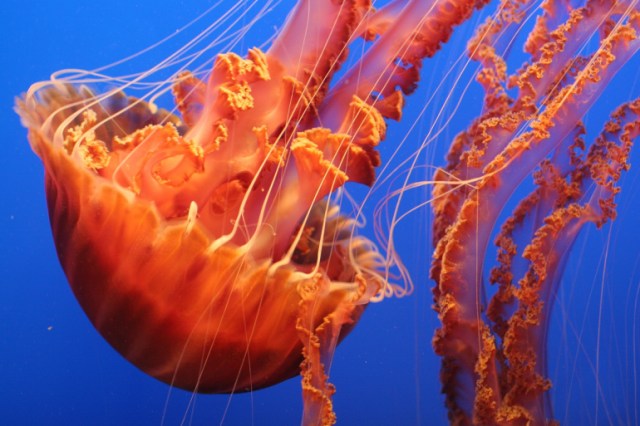Stinging jellyfish are an obsession that threatens marine life in several regions around the world, and jellyfish stings are a great threat to vacationers in coastal areas, as well as causing tremendous economic damage.
In a new study prepared by a team of several Chinese research institutes, and details of which were published in the journal "Research Research" on June 19, the researchers succeeded in analyzing this deadly poison of the giant jellyfish.
Researchers have discovered an incredibly complex mixture of over 200 toxins associated with the jellyfish sting, each of which can target specific organs or damage many systems of the human body.
Nomori is known
The giant jellyfish known as "Namura" is one of the largest species of jellyfish in the world, and it bites hundreds of thousands of swimmers every year.
The lamp is known scientifically as "Nemopilema nomurai", and the genus Numori is from the root-mouthed family, which is a group of animals from the Congolese group.
And the jellyfish "Namura" is characterized by a huge ability to grow, and weighs more than 204 kilograms, which is a dangerous type of jellyfish that bites a large number of victims and causes many deaths annually.
Injuries caused by the "Namura" sting include blood vessels congestion, hemolysis, liver cell death, kidney changes, and inflammation of the lungs.
As for the poison "Namura" it is a complex mixture of proteins, and previous studies have identified hundreds of toxins (toxins) in this dreadful mixture.
And scientists are not sure what makes him fatal. When the sting occurs, his poison causes immediate and severe pain, followed by redness and swelling, and in rare cases, bites can lead to severe injury or even end in death.
The killer part
In this new study, the researchers isolated the killer part of "Namura" by cutting and freezing hooks removed directly from the living giant jellyfish, and centrifuges were used to collect stinging cells, which are specialized cells that contain poison.
The researchers extracted the toxin proteins very carefully, then separated them into different groups, and injected every part of these proteins into mice.
By deciphering the genomic sequence, the transcriptome (the entire set of transcriptors in an organism that reflects the expression of genes at a specific time), and the identification of proteins (the comprehensive study of all types of proteins), scientists have been able to discover the major deadly toxins of the giant jellyfish.
Their results shed light on a group of 13 toxin-like proteins, some of which target cell membranes, some of which target potassium channels, and affect blood clotting.
After analyzing the dead mice, the researchers found that pulmonary infection and "edema" were the most likely cause of death, which is consistent with forensic reports, as the results of toxicology were consistent with the clinical symptoms of patients who died after the "Namura" sting.
Edema is swelling caused by excess fluid trapped in the tissues of the body. They are most noticeable in hands, arms, feet, ankles, and legs.
The results revealed that the target toxins played very important roles in the deadly effect of the bite, however researchers acknowledge that it is difficult to say with certainty how each of these individual toxins actually kills animals, indicating that toxinemia may be involved synergistically in this effect.
The toxin, toxin, or toxin is a protein bio-toxin that some organisms make from plants and animals such as castor seed toxin (ricin) or whooping cough toxin.
A very important step
In the end, we still don't know what makes the poison of this creature so dangerous and deadly for some people, but we're getting close to finding the really deadly ingredient.
The results of this study enhance understanding of the deadly effect caused by the jellyfish sting. A better understanding of this toxin mixture may help us in developing an antidote to this sting, but we will first need to explore why these toxins pose a deadly danger to humans.
This step will be very important for the development of medications to treat giant jellyfish sting in the near future.

